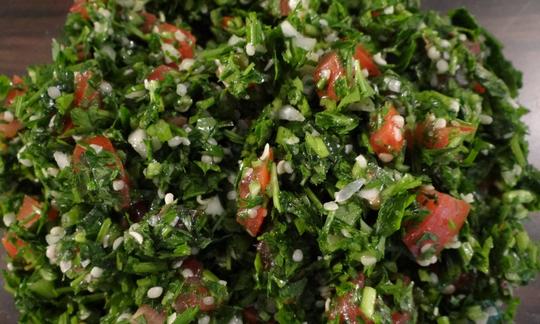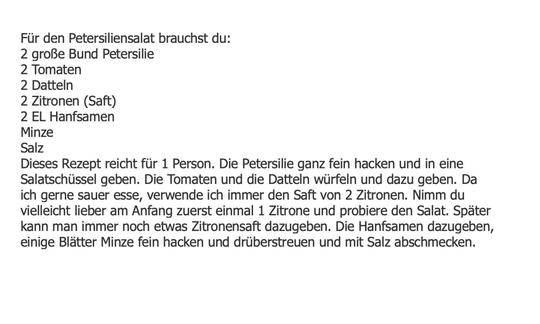parsley salad with tomatoes and lemon juice
raw-vegan
Ingredients (for serving, )
| 2 bunch | Parsley, fresh, raw (leaf parsley, parsley) (2.1 oz) |
| 2 | Tomatoes, raw (organic?) (8.6 oz) |
| 2 | Dates, Medjool variety, pitted, raw? (organic?) (1.7 oz) |
| 2 | Lemons, raw (limes, organic?) (4.1 oz) |
| 2 tbsp | Hemp seeds, unpeeled, raw, organic? (0.34 oz) |
| 10 leaves | Moroccan mint, raw (organic?) (0.05 oz) |
| 1 dash | Table salt (table salt, raw?, organic?) (0.01 oz) |
Equipment
- citrus juicer (lemon squeezer)
Type of preparation
- chop or grind
- food preparation without heating
- squeeze
- season to taste
Preparation
For the salad
Wash the parsley and tomatoes. Chop the parsley very finely and put it in a salad bowl. Dice the tomatoes and dates and add them.The original recipe does not specify a specific type of date. We chose the Medjool variety because it has a very soft consistency and is easy to chop.
For the dressing
Squeeze the juice from the lemons and add to the salad. Add the hemp seeds, finely chop a few mint leaves and sprinkle over the top and season with salt.Tip: First use 1 lemon and taste the salad. You can always add a little lemon juice later.
There is no exact information on the number of mint leaves, you decide for yourself. Moroccan mint is milder than peppermint, which has a higher menthol content.
|
Nutritional Information per person
Convert per 100g
|
2000 kcal | |
|---|---|---|
| Energy | 278 kcal | 13.9% |
| Fat/Lipids | 4.5 g | 6.5% |
| Saturated Fats | 0.50 g | 2.5% |
| Carbohydrates (inc.dietary fiber) | 63 g | 23.5% |
| Sugars | 42 g | 46.6% |
| Fiber | 14 g | 57.4% |
| Protein/Albumin | 8.6 g | 17.2% |
| Cooking Salt (Na:206.9 mg) | 525 mg | 21.9% |
| Essential micronutrients with the highest proportions | per person | 2000 kcal | |
|---|---|---|---|
| Vit | Vitamin K | 294 µg | 391.0% |
| Vit | Vitamin C (ascorbic acid) | 175 mg | 219.0% |
| Vit | Folate, as the active form of folic acid (née vitamin B9 and | 157 µg | 78.0% |
| Elem | Potassium, K | 1'530 mg | 76.0% |
| Min | Copper, Cu | 0.64 mg | 64.0% |
| Min | Iron, Fe | 6.7 mg | 48.0% |
| Min | Manganese, Mn | 0.92 mg | 46.0% |
| Vit | Vitamin A, as RAE | 363 µg | 45.0% |
| Elem | Magnesium, Mg | 143 mg | 38.0% |
| Vit | Vitamin B6 (pyridoxine) | 0.50 mg | 36.0% |
Detailed Nutritional Information per Person for this Recipe
The majority of the nutritional information comes from the USDA (US Department of Agriculture). This means that the information for natural products is often incomplete or only given within broader categories, whereas in most cases products made from these have more complete information displayed.
If we take flaxseed, for example, the important essential amino acid ALA (omega-3) is only included in an overarching category whereas for flaxseed oil ALA is listed specifically. In time, we will be able to change this, but it will require a lot of work. An “i” appears behind ingredients that have been adjusted and an explanation appears when you hover over this symbol.
For Erb Muesli, the original calculations resulted in 48 % of the daily requirement of ALA — but with the correction, we see that the muesli actually covers >100 % of the necessary recommendation for the omega-3 fatty acid ALA. Our goal is to eventually be able to compare the nutritional value of our recipes with those that are used in conventional western lifestyles.
| Essential fatty acids | per person | 2000 kcal |
|---|---|---|
| Alpha-Linolenic acid; ALA; 18:3 omega-3 | 0.57 g | 28.0% |
| Linoleic acid; LA; 18:2 omega-6 | 2.4 g | 24.0% |
| Essential amino acids | per person | 2000 kcal |
|---|---|---|
| Tryptophan (Trp, W) | 0.09 g | 36.0% |
| Threonine (Thr, T) | 0.26 g | 28.0% |
| Isoleucine (Ile, I) | 0.24 g | 20.0% |
| Phenylalanine (Phe, F) | 0.30 g | 19.0% |
| Valine (Val, V) | 0.31 g | 19.0% |
| Leucine (Leu, L) | 0.38 g | 16.0% |
| Lysine (Lys, K) | 0.30 g | 16.0% |
| Methionine (Met, M) | 0.10 g | 11.0% |
| Vitamins | per person | 2000 kcal |
|---|---|---|
| Vitamin K | 294 µg | 391.0% |
| Vitamin C (ascorbic acid) | 175 mg | 219.0% |
| Folate, as the active form of folic acid (née vitamin B9 and | 157 µg | 78.0% |
| Vitamin A, as RAE | 363 µg | 45.0% |
| Vitamin B6 (pyridoxine) | 0.50 mg | 36.0% |
| Thiamine (vitamin B1) | 0.26 mg | 24.0% |
| Biotin (ex vitamin B7, H) | 12 µg | 24.0% |
| Vitamin E, as a-TEs | 2.8 mg | 23.0% |
| Niacin (née vitamin B3) | 3.4 mg | 21.0% |
| Pantothenic acid (vitamin B5) | 1.1 mg | 18.0% |
| Riboflavin (vitamin B2) | 0.18 mg | 13.0% |
| Essential macroelements (macronutrients) | per person | 2000 kcal |
|---|---|---|
| Potassium, K | 1'530 mg | 76.0% |
| Magnesium, Mg | 143 mg | 38.0% |
| Sodium, Na | 207 mg | 26.0% |
| Calcium, Ca | 203 mg | 25.0% |
| Phosphorus, P | 143 mg | 20.0% |
| Essential trace elements (micronutrients) | per person | 2000 kcal |
|---|---|---|
| Copper, Cu | 0.64 mg | 64.0% |
| Iron, Fe | 6.7 mg | 48.0% |
| Manganese, Mn | 0.92 mg | 46.0% |
| Zinc, Zn | 2.0 mg | 20.0% |
| Iod, I (Jod, J) | 6.1 µg | 4.0% |
| Selenium, Se | 0.52 µg | 1.0% |
| Fluorine, F | 15 µg | < 0.1% |
The parsley salad with tomatoes and lemon juice is particularly rich in vitamins K and C and is very easy to prepare.
Nutrient profile: According to GDA guidelines, one portion of this recipe covers almost 4 times the average daily requirement of vitamin K and more than double that of vitamin C. Folic acid and potassium are covered by a good three-quarters, and iron is almost 50%. The ratio of omega-6 to omega-3 fatty acids is 4:1, which is below the recommended maximum ratio of 5:1. You can find out more at the following link: Vegans often eat unhealthily. Avoidable nutritional errors.
Parsley: Parsley usually only plays a supporting role in a dish. But in addition to using fresh parsley as an extra flavor, you can also use it in a salad. Parsley is a source of flavonoids, antioxidants and vitamins, especially vitamins K, C and A, which makes this kitchen herb suitable for more than just a garnish. There is the curly leaf parsley described here, the root parsley and the flat-leaf parsley. The latter is considered to be spicier than the curly leaf parsley and the root parsley is the strongest in flavor. All parts of the parsley plant have a strong, spicy-bitter flavor, with the often less noticed stems being particularly aromatic. From a medicinal point of view, parsley has a cleansing, disinfectant, diuretic, antispasmodic and expectorant effect.
Tomatoes: The tomato consists of approximately 95% water and mainly contains vitamins A, B1, B2, C, E, niacin, secondary plant substances and minerals (especially potassium) and trace elements. The skin of the tomato contains polysaccharides, cutin, hydrocarbons and fatty acids and contains flavonoids.
Dates: The date fruit with its honey-like sweet taste is actually a berry fruit. Dates are therefore often used as a sweetener in healthy cooking. It is rich in vitamin B6 and the minerals copper and potassium. It also contains more fiber than conventional wholemeal bread.
Hemp seeds: Hemp seeds are available in peeled and unpeeled form. Unpeeled hemp seeds are very crunchy and, roasted or unroasted, add a nutty, oily flavor to salads in particular. To make the unpeeled hemp seeds easier to digest, it helps to soak them in water for a few hours before use. Raw hemp seeds contain all essential amino acids. They also have a very good ratio of omega-6 to omega-3 fatty acids at 3:1.
Optimal storage of tomatoes: Tomatoes are best stored at 13 to 18 °C and at a relative humidity of 80 to 95%. Under good storage conditions, tomatoes can be kept for up to 14 days. Storing them in the refrigerator is definitely not recommended, as this not only reduces the production of volatile aromas, but also reduces their content in the fruit after a few days.
Vitamin C promotes iron absorption: To promote the conversion of plant-based trivalent iron (Fe 3+) into the more easily absorbed divalent iron (Fe 2+), it helps to consume foods containing vitamin C (see link to vitamin C). As a guideline, a minimum amount of around 25 mg of vitamin C is assumed to significantly increase iron absorption when consumed at the same time. This corresponds to around 50 mL of orange juice or 70 mL of lemon juice as a salad dressing.
Acidity: Depending on the desired acidity, you can increase or reduce the amount of lemon juice.





